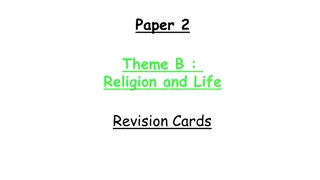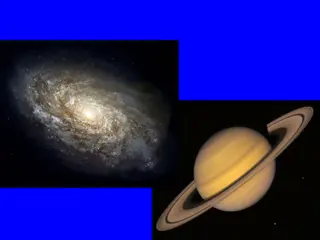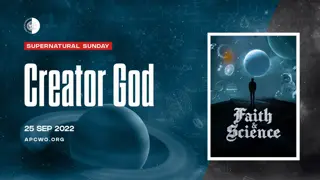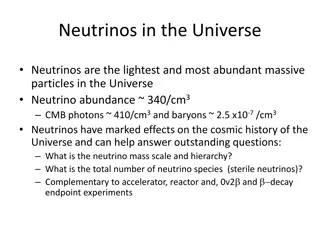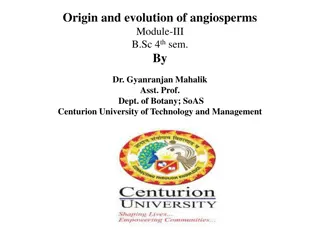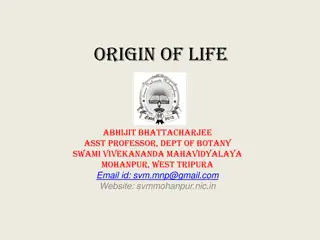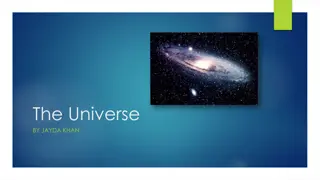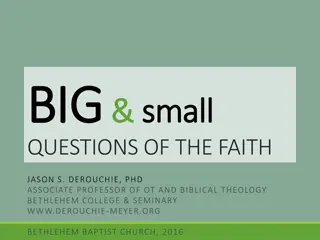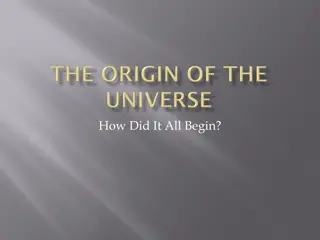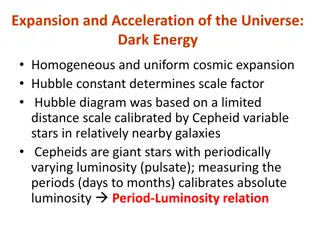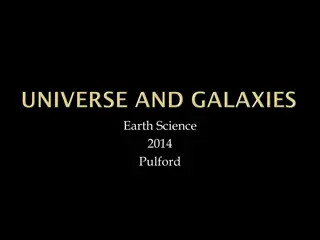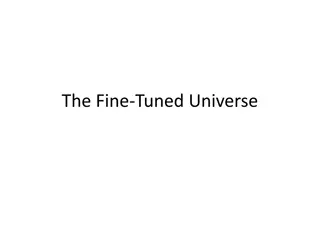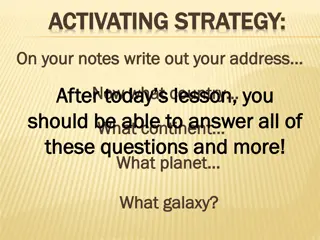The Origin and Evolution of the Universe
Debate in medieval philosophy over the universe's past, Kepler's finite universe theory, Newton's motion principles, and Poe's "Primordial Particle" concept. The Big Bang theory by Georges Lemaître and Edwin Hubble, with Friedmann's dynamic cosmological model. Also covers the Steady State theory and the cosmic microwave background radiation. Explains the Big Bang model detailing the early universe's hot, dense state leading to expansion and cooling, forming subatomic particles and atomic nuclei.
Download Presentation

Please find below an Image/Link to download the presentation.
The content on the website is provided AS IS for your information and personal use only. It may not be sold, licensed, or shared on other websites without obtaining consent from the author.If you encounter any issues during the download, it is possible that the publisher has removed the file from their server.
You are allowed to download the files provided on this website for personal or commercial use, subject to the condition that they are used lawfully. All files are the property of their respective owners.
The content on the website is provided AS IS for your information and personal use only. It may not be sold, licensed, or shared on other websites without obtaining consent from the author.
E N D
Presentation Transcript
BEGINNING OF THE UNIVERSE In Medieval philosophy there was much debate over whether the universe had a finite In Medieval philosophy there was much debate over whether the universe had a finite or infinite past or infinite past Johannes Johannes Kepler Kepler used the dark night sky to argue for a finite universe. used the dark night sky to argue for a finite universe. Isaac Newton Isaac Newton described large described large- -scale motion throughout the universe. scale motion throughout the universe. Edger Allen Poe Edger Allen Poe believed the initial state of matter was a single "Primordial Particle". believed the initial state of matter was a single "Primordial Particle".
BIG BANG In 1927, the Belgian Catholic priest Georges Lematire proposed an expanding In 1927, the Belgian Catholic priest Georges Lematire proposed an expanding model for the universe to explain the observed redshifts of spiral nebulae. model for the universe to explain the observed redshifts of spiral nebulae. He based his theory on the work of Einstein and De Sitter He based his theory on the work of Einstein and De Sitter In 1929, Edwin Hubble provided a comprehensive foundation for Lema tre's In 1929, Edwin Hubble provided a comprehensive foundation for Lema tre's theory. theory. Hubble discovered that relative to the Earth and all other observed bodies, Hubble discovered that relative to the Earth and all other observed bodies, galaxies are receding in every direction galaxies are receding in every direction Hubble proved the isotropic nature of the expansion was direct proof that space was Hubble proved the isotropic nature of the expansion was direct proof that space was expanding, not that the bodies in space that were simply moving further outward expanding, not that the bodies in space that were simply moving further outward Alexander Alexander Alexandrovich Alexandrovich Friedmann the big bang the big bang Friedmann formed the first dynamic cosmopolitan model of formed the first dynamic cosmopolitan model of
OTHER THEORIES The steady state theory The steady state theory states that change its appearance over change its appearance over time; it Discredited by the detection of the cosmic microwave background radiation states that although the universe is expanding, it although the universe is expanding, it does time; it has no beginning and no end has no beginning and no end. . does not not
WHAT IS THE BIG BANG The Big Bang theory is the cosmological model that explains the earliest moments The Big Bang theory is the cosmological model that explains the earliest moments development of the observable Universe. According to the theory, the Universe development of the observable Universe. According to the theory, the Universe was once in an extremely hot and dense state which expanded rapidly. This rapid was once in an extremely hot and dense state which expanded rapidly. This rapid expansion caused the Universe to cool and resulted in its present continuously expansion caused the Universe to cool and resulted in its present continuously expanding state. After expanding state. After its initial expansion from a singularity the Universe cooled its initial expansion from a singularity the Universe cooled to to allow energy to be converted into various subatomic allow energy to be converted into various subatomic particles. and neutrons combined to form the first atomic nuclei only a few minutes after and neutrons combined to form the first atomic nuclei only a few minutes after the Big Bang, it would take thousands of years for electrons to combine with them the Big Bang, it would take thousands of years for electrons to combine with them and create electrically neutral atoms. and create electrically neutral atoms. particles. While protons While protons According to the most recent measurements and observations, the Big Bang occurred According to the most recent measurements and observations, the Big Bang occurred approximately 13.75 billion years ago, which is thus considered the age of the approximately 13.75 billion years ago, which is thus considered the age of the Universe Universe
END OF THE UNIVERSE Since it was discovered that there could be a beginning to the Universe, it was Since it was discovered that there could be a beginning to the Universe, it was possible that the Universe could end. possible that the Universe could end. Cosmologists aimed to determine the fate of the universe by measuring Omega . Cosmologists aimed to determine the fate of the universe by measuring Omega . The Universe has different fates depending on the value of Omega . The Universe has different fates depending on the value of Omega . If omega greater than 1, then the universe will be closed. If it's less than 1, the universe greater than 1, then the universe will be closed. If it's less than 1, the universe will be open. And if it's equal to 1, the universe will be flat will be open. And if it's equal to 1, the universe will be flat If omega is is
BIG CRUNCH According to this theory, the universe will one day stop expanding. Then, as gravity According to this theory, the universe will one day stop expanding. Then, as gravity pulls on the matter, the universe will begin to contract, falling inward until it has pulls on the matter, the universe will begin to contract, falling inward until it has collapsed back into a super collapsed back into a super- -hot, super hot, super- -dense singularity dense singularity. . It is considered a consequence of the Big Bang It is considered a consequence of the Big Bang
PROBLEMS WITH EXPANSION/ CONTRACTION Theory of General Relativity and Quantum Mechanics are incompatible at quantum Theory of General Relativity and Quantum Mechanics are incompatible at quantum scales when large mass is involved. scales when large mass is involved. Since quantum mechanics is mostly probability and relativity is mostly definitive, the Since quantum mechanics is mostly probability and relativity is mostly definitive, the two theories cannot be used in tandem. two theories cannot be used in tandem. The big bang and big crunch are unable to be described on a quantum and relative The big bang and big crunch are unable to be described on a quantum and relative scale. scale.
THE END THE END


![Read⚡ebook✔[PDF] Life in the Universe: Expectations and Constraints (Springer P](/thumb/21626/read-ebook-pdf-life-in-the-universe-expectations-and-constraints-springer-p.jpg)

